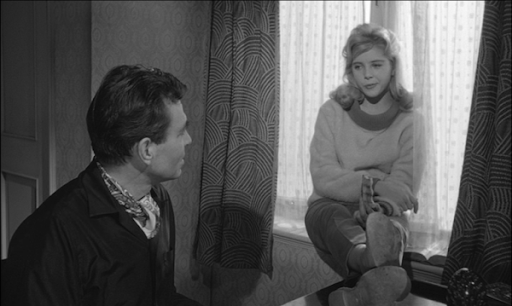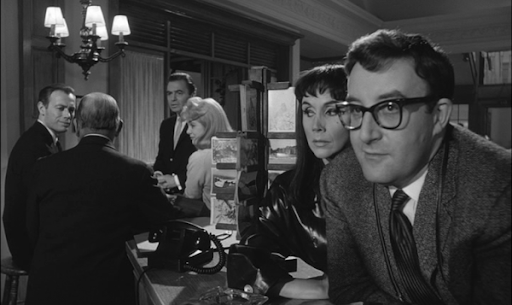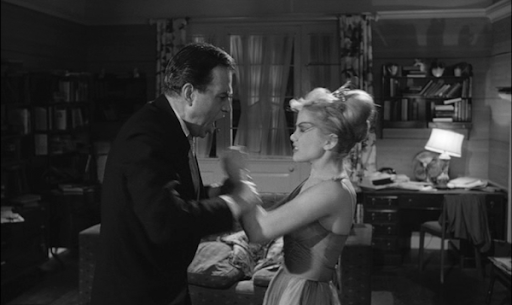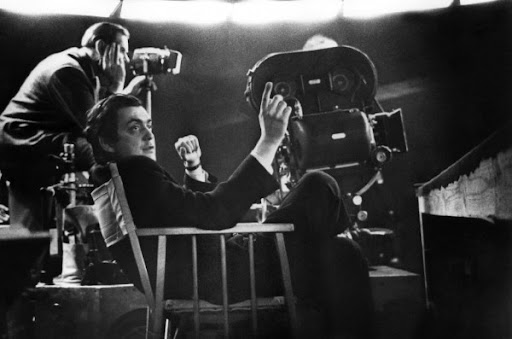Well...
Things are back to normal around here, so we're going to be posting like crazy for the next week. L&S threatened me about posting any more of "...that horrid jungle music!", so I'm going to stick with classic films and "music for boring white people". I hope you're all into Train, Plain White Tee's, and Maroon 5...cuz I'm sick of getting yelled at.
Here's Stanley Kubrick's masterpiece, Lolita. Expect a flood of great posts over the next week or so...and thanks again to all our visitors.
Editorial Note: The phrases "...that horrid jungle music!" and "music for boring white people" are complete fabrications of leclisse's imagination and have never been uttered by any member of ForTheDishwasher besides himself. The insinuation that L&S enjoys the music of Train, Plain White Tee's and Maroon 5 is also slander and should be ignored.

From Robert Stam:
Reflexive films have often been "bad objects" for critics, who resent their sabotaging of the conventional pleasures of illusion and identification. It is surely no accident that Woody Allen’s most widely despised film [Stardust Memories] is also his most self-conscious and avant-gardist. The critics complained that "the characters do not come alive" and "the big scenes never take off," apparently failing to notice that the film is consciously built on a principle of systematic interruption familiar from the self-conscious tradition. It is only because of the differential expectations applied to literature and the cinema that the disruptive techniques lauded in prose fiction are rejected as hostile and self-indulgent in film. Modernist and reflexive strategies, accepted in literature, remain, at least for the mainstream of journalistic critics, anathema in the cinema.
Many of the cinematic adaptations of self-conscious novels, including the more successful ones, often flounder on precisely this point. While they incorporate certain reflexive devices, they do not metalinguistically dissect their own practice or include critical discourse within the text itself. The mainstream fiction film’s relative impermeability to reflexivity explains the partial failure of Stanley Kubrick’s adaptation of Lolita (1962). While the novel constantly flaunts its own status as linguistic artifact, the film is largely cast in the illusionistic mould, presenting rounded characters in plausible settings through a self-effacing style. While the book is a veritable palimpsest of parodies—of Proust, Poe, Dostoyevsky, Sade—Kubrick opted to downplay style in a text in which style is of the essence. The film is intermittently parodic—the homage to Chaplin’s tussle with a bed in One A.M., the allusion to Kubrick’s own Spartacus, the disorienting direct cut to The Curse of Frankenstein—but never so consistently or effectively as the novel. Most of the Nabokovian wit is displaced onto Peter Sellers as Clare Quilty, for Sellers’ shape-shifting capacity to mimic personages as diverse as Gabby Hayes and T.S. Eliot makes him an ambulatory intertext, a body of quotations whose very modus operandi is parodic in the best Nabokovian sense.

Nabokov’s screenplay, of which Kubrick used but a small portion, is rather more audacious, although Nabokov himself recognizes in its preface that the "author’s goal of infinite fidelity" may be a "producer’s ruin." The screenplay includes a cameo role for Nabokov himself, a Hitchcockian touch that recalls his guest appearance in his own Despair, and which would have constituted the filmic equivalent of his anagrammatic presence in Lolita as Vivian Darkbloom. The Nabokov screenplay also expands the role of the pedantic D. John Ray, developing a constant interplay between Ray presenting Humbert’s notes and Humbert presenting himself. The screenplay is more prone to interruption and dedramatization. Charlotte’s fateful car crash is treated less dramatically, for example, by means of a quick cut to traffic policemen examining diagrams of the accident, a narrative dislocation which visually translates the nonchalantly perverse syntax of Humbert’s account of his wife’s death.
Lolita is, among other things, a fine work of film and literary criticism. But Kubrick fails to exploit the cinematic references (lovingly inventoried by Alfred Appel, Jr. in Nabokov’s Dark Cinema) in the novel; the envy of cinema’s "fantastic simultaneousness"; the description of Humbert himself as a "handsome hunk of movie and manhood" or Charlotte as a "weak solution of Marlene Dietrich"; the advice proffered to any future filmic translator of his work ("If you want to make a movie of my book, have one of those faces gently melt into my own, while I look"); and the incisive discussions of Lolita’s generic tastes. Indeed, Nabokov shows himself to be a brilliant genre critic. He artfully details the formulaic visuals of westerns: "the rearing horse, the spectacular stampede, the pistol thrust through the slivered windowpane, the stupendous fistfight, the crashing mountain of dusty old-fashioned furniture, the table used as a weapon, the timely somersault, the pinned hand still groping for the dropped bowie knife He describes musicals, meanwhile, as a "grief-proof sphere of existence where from death and truth were banned" and "underworlders" as fostering a "robust atmosphere of incompetent marksmanship."

While Nabokov constantly highlights the verbal factitiousness of his text, Kubrick finds no filmic equivalent for this device. While the novel frequently violates the reader’s expectations, the film rarely does. The novel consistently disorients its reader, especially as to the degree of "sincerity" of the text, while the film almost never does (the sudden cut to the drive-in horror film constituting a rare exception). While the novel systematically develops contradictions between what is being related (for example, Charlotte’s death) and the tone and style in which it is being related, the film is, in the main, stylistically homogenous. While the novel conveys eroticism through hilarious indirection, applying sexual language to non-sexual events and vice versa, the film conveys eroticism largely through love scenes (as explicit as censorship would then allow), through point-of-view editing, and through shots of characters’ whispering ("Did I do that!" Quilty responds to Charlotte’s whispered insinuations). In short, Kubrick substitutes three-dimensional illusionism and stylistic continuity for the recklessly flamboyant virtuoso anti-illusionism of the book. One almost wishes that a later Kubrick, the Kubrick of Strangelove and especially of Clockwork Orange, might take another try at Nabokov’s novel.

Technical Information:
Title: Lolita
Year: 1962
Country: USA
Director: Stanley Kubrick
Source: DVD9 Retail
DVD Format: PAL
Container: .iso + mds
Size: 6.47 GB
Length: 2:27:13
Programs used: Unknown
Resolution: 720x576
Aspect Ratio: 16:9
Video: MPEG2 @ ~ 6800 kb/s
Frame Rate: 25 fps
Audio 1: English- Dolby AC3 Mono @ 192 kb/s
Audio 2: French- Dolby AC3 Mono @ 192 kb/s
Audio 3: Italian- Dolby AC3 Mono @ 192 kb/s
Subtitles: English, Dutch, French, Italian, Arabic, Spanish (Catilian), Portuguese, German, Romanian, Bulgarian, cc-English, cc-Italian
Menu: Yes
Video: Untouched
DVD Extras: Theatrical Trailer, Awards

(Use JDownloader to automate downloading)
Lolita Megaupload Links


